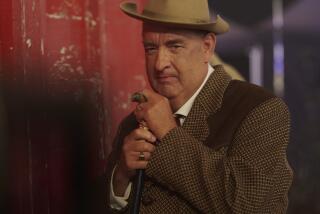Cusack Makes a Killing as the Star of ‘Grosse Pointe’
- Share via
IRVINE — In “Grosse Pointe Blank,” a young professional hit man (John Cusack) fends off a rival’s attack as he returns to his hometown for his 10th high school reunion and tries to pick up where he left off with his old sweetheart (Minnie Driver). (Rated R)
Not your typical Terminator, Martin Blank regards himself as just another Gen Xer, raised in suburbia, who’s trying to sort out love and career issues amid the absurdity of modern life. He sees a shrink. He dresses like Anthony Robbins. He watches what he eats.
And he kills anyone he’s paid to.
That’s what made the movie funny, according to Chris Cooke, 13. “It’s different,” he said. “It’s kind of dark humor.”
Chris said he has grown up on action films, the ones with stars “like Arnold or Jean Claude--’Die Hard’-type movies,” and so he could appreciate the ironic spin on the genre.
When he returns to his hometown, for instance, Martin nonchalantly offers a truthful answer to everyone who asks what he’s doing now: He tells them he’s a professional killer. “Everybody laughed about it. They thought it was a joke. The whole movie, he’s killing people and nobody knew it,” Chris said.
Chris had previously seen Cusack only in supporting roles. “He’s always been pretty funny,” he said. “I like him as the main star now. He played a really good assassin. He’s very limber so he could pull off some moves,” he said.
But no one would mistake the lanky Cusack for your usual action hero. “Arnold’s the tough guy, and this guy has emotions,” Chris said. “Jean Claude Van Damme is more like a combat guy who knows a few kicks. That what makes it so fun. [Cusack is] in between somewhere.”
Martin performs his job duties with a cool deadpan reminiscent of Woody Allen, while the rest of the world is oblivious. He talks on a cell phone to his assistant (played by Cusack’s sister, Joan Cusack) in the midst of a hit; a young mini-mart clerk listens to music through earphones and plays a video game, unaware that a gun battle involving Martin rages behind him.
“When the store got blown up, [the clerk] went outside and was all mad because he had to get a new job. He didn’t care that the shop was blown up,” Chris said.
At the end, the movie turned more serious, he said. In one grisly scene at the reunion, Martin uses a ballpoint pen to stab an attacker in the neck. He dispatches two FBI agents and shoots up his sweetheart’s house. Still, Chris said he was laughing because Martin was trying to profess his love to the girl while simultaneously blowing people away.
He also liked Minnie Driver as the skeptical former girlfriend Martin dumped on prom night and is trying to woo back. Amanda Smith, 15, of Irvine, who remembered her as an unattractive loner in “Circle of Friends,” said Driver has transformed into a beautiful romantic lead.
*
AT ISSUE: Researchers at UC Santa Barbara recently announced a study showing that portrayals of violence--at least on TV--remain “sanitized” and fail to show victims suffering any pain.
Programs that impart the highest risk of teaching aggressive behaviors and attitudes to children are those in which the perpetrator is attractive, the violence seems justified, the violence goes unpunished, there are minimal consequences to the victim, and in which the violence seems realistic to the viewer, the researchers noted.
Does violence in black comedies such as “Pulp Fiction,” “Fargo” and “Grosse Pointe Blank” have a different impact on kids from the violence of typical action films?
No, according to Laurie Trotta, director of communications for Mediascope, a media policy group in Los Angeles. In fact, she said, research shows that the combination of humor and violence can make it worse. “It makes light of violence, and kids don’t see the repercussions. It can make us insensitive about violence,” she said.
More to Read
Only good movies
Get the Indie Focus newsletter, Mark Olsen's weekly guide to the world of cinema.
You may occasionally receive promotional content from the Los Angeles Times.





